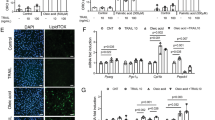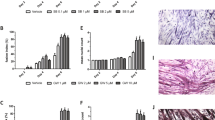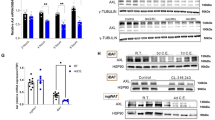Abstract
Background:
Myostatin, also known as Growth and Differentiation Factor 8, is a secreted protein that inhibits muscle growth. Disruption of myostatin signaling increases muscle mass and decreases glucose, but it is unclear whether these changes are related. We treated mice on chow and high-fat diets with a soluble activin receptor type IIB (ActRIIB, RAP-031), which is a putative endogenous signaling receptor for myostatin and other ligands of the TGF-β superfamily.
Results:
After 4 weeks, RAP-031 increased lean and muscle mass, grip strength and contractile force. RAP-031 enhanced the ability of insulin to suppress glucose production under clamp conditions in high-fat fed mice, but did not significantly change insulin-mediated glucose disposal. The hepatic insulin-sensitizing effect of RAP-031 treatment was associated with increased adiponectin levels. RAP-031 treatment for 10 weeks further increased muscle mass and drastically reduced fat content in mice on either chow or high-fat diet. RAP-031 suppressed hepatic glucose production and increased peripheral glucose uptake in chow-fed mice. In contrast, RAP-031 suppressed glucose production with no apparent change in glucose disposal in high-fat-diet mice.
Conclusion:
Our findings show that disruption of ActRIIB signaling is a viable pharmacological approach for treating obesity and diabetes.
This is a preview of subscription content, access via your institution
Access options
Subscribe to this journal
Receive 12 print issues and online access
$259.00 per year
only $21.58 per issue
Buy this article
- Purchase on Springer Link
- Instant access to full article PDF
Prices may be subject to local taxes which are calculated during checkout






Similar content being viewed by others
References
McPherron AC, Lee SJ . Double muscling in cattle due to mutations in the myostatin gene. Proc Natl Acad Sci USA 1997; 94: 12457–12461.
McPherron AC, Lawler AM, Lee SJ . Regulation of skeletal muscle mass in mice by a new TGF-beta superfamily member. Nature 1997; 387: 83–90.
Mosher DS, Quignon P, Bustamante CD, Sutter NB, Mellersh CS, Parker HG et al. A mutation in the myostatin gene increases muscle mass and enhances racing performance in heterozygote dogs. PLoS Genet 2007; 3: e79.
Schuelke M, Wagner KR, Stolz LE, Hubner C, Riebel T, Komen W et al. Myostatin mutation associated with gross muscle hypertrophy in a child. N Engl J Med 2004; 350: 2682–2688.
Bogdanovich S, Krag TO, Barton ER, Morris LD, Whittemore LA, Ahima RS et al. Functional improvement of dystrophic muscle by myostatin blockade. Nature 2002; 420: 418–421.
Bogdanovich S, Perkins KJ, Krag TO, Whittemore LA, Khurana TS . Myostatin propeptide-mediated amelioration of dystrophic pathophysiology. FASEB J 2005; 19: 543–549.
Suzuki ST, Zhao B, Yang J . Enhanced muscle by myostatin propeptide increases adipose tissue adiponectin, PPAR-alpha, and PPAR-gamma expressions. Biochem Biophys Res Commun 2008; 369: 767–773.
Haidet AM, Rizo L, Handy C, Umapathi P, Eagle A, Shilling C et al. Long-term enhancement of skeletal muscle mass and strength by single gene administration of myostatin inhibitors. Proc Natl Acad Sci USA 2008; 105: 4318–4322.
Artaza JN, Bhasin S, Magee TR, Reisz-Porszasz S, Shen R, Groome NP et al. Myostatin inhibits myogenesis and promotes adipogenesis in C3H 10T(1/2) mesenchymal multipotent cells. Endocrinology 2005; 146: 3547–3557.
Feldman BJ, Streeper RS, Farese Jr RV, Yamamoto KR . Myostatin modulates adipogenesis to generate adipocytes with favorable metabolic effects. Proc Natl Acad Sci USA 2006; 103: 15675–15680.
Kim HS, Liang L, Dean RG, Hausman DB, Hartzell DL, Baile CA . Inhibition of preadipocyte differentiation by myostatin treatment in 3T3-L1 cultures. Biochem Biophys Res Commun 2001; 281: 902–906.
Rebbapragada A, Benchabane H, Wrana JL, Celeste AJ, Attisano L . Myostatin signals through a transforming growth factor beta-like signaling pathway to block adipogenesis. Mol Cell Biol 2003; 23: 7230–7242.
Allen DL, Cleary AS, Speaker KJ, Lindsay SF, Uyenishi J, Reed JM et al. Myostatin, activin receptor IIb, and follistatin-like-3 gene expression are altered in adipose tissue and skeletal muscle of obese mice. Am J Physiol Endocrinol Metab 2008; 294: E918–E927.
Hittel DS, Berggren JR, Shearer J, Boyle K, Houmard JA . Increased secretion and expression of myostatin in skeletal muscle from extremely obese women. Diabetes 2009; 58: 30–38.
Lee SJ, Reed LA, Davies MV, Girgenrath S, Goad ME, Tomkinson KN et al. Regulation of muscle growth by multiple ligands signaling through activin type II receptors. Proc Natl Acad Sci USA 2005; 102: 18117–18122.
Wilkes JJ, Lloyd DJ, Gekakis N . A loss-of-function mutation in myostatin reduces TNF{alpha} production and protects liver. Diabetes 2009; 58: 1133–1143.
McPherron AC, Lee SJ . Suppression of body fat accumulation in myostatin-deficient mice. J Clin Invest 2002; 109: 595–601.
Zhao B, Wall RJ, Yang J . Transgenic expression of myostatin propeptide prevents diet-induced obesity and insulin resistance. Biochem Biophys Res Commun 2005; 337: 248–255.
Morrison BM, Lachey JL, Warsing LC, Ting BL, Pullen AE, Underwood KW et al. A soluble activin type IIB receptor improves function in a mouse model of amyotrophic lateral sclerosis. Exp Neurol 2009; 217: 258–268.
Takahashi N, Patel HR, Qi Y, Dushay J, Ahima RS . Divergent effects of leptin in mice susceptible or resistant to obesity. Horm Metab Res 2002; 34: 691–697.
Varela GM, Antwi DA, Dhir R, Yin X, Singhal NS, Graham MJ et al. Inhibition of ADRP prevents diet-induced insulin resistance. Am J Physiol Gastrointest Liver Physiol 2008; 295: G621–G628.
Singhal NS, Lazar MA, Ahima RS . Central resistin induces hepatic insulin resistance via neuropeptide Y. J Neurosci 2007; 27: 12924–12932.
Moens P, Baatsen PH, Marechal G . Increased susceptibility of EDL muscles from mdx mice to damage induced by contractions with stretch. J Muscle Res Cell Motil 1993; 14: 446–451.
Petrof BJ, Shrager JB, Stedman HH, Kelly AM, Sweeney HL . Dystrophin protects the sarcolemma from stresses developed during muscle contraction. Proc Natl Acad Sci USA 1993; 90: 3710–3714.
Mendias CL, Marcin JE, Calerdon DR, Faulkner JA . Contractile properties of EDL and soleus muscles of myostatin-deficient mice. J Appl Physiol 2006; 101: 898–905.
Leibel RL, Hirsch J . Metabolic characterization of obesity. Ann Intern Med 1985; 103: 1000–1002.
Kahn BB, Flier JS . Obesity and insulin resistance. J Clin Invest 2000; 106: 473–481.
Hotamisligil GS . Inflammation and metabolic disorders. Nature 2006; 444: 860–867.
Galgani JE, Moro C, Ravussin E . Metabolic flexibility and insulin resistance. Am J Physiol Endocrinol Metab 2008; 295: E1009–E1017.
Moro C, Bajpeyi S, Smith SR . Determinants of intramyocellular triglyceride turnover: implications for insulin sensitivity. Am J Physiol Endocrinol Metab 2008; 294: E203–E213.
Pedersen BK, Febbraio MA . Muscle as an endocrine organ: focus on muscle-derived interleukin-6. Physiol Rev 2008; 88: 1379–1406.
Zimmers TA, Davies MV, Koniaris LG, Haynes P, Esquela AF, Tomkinson KN et al. Induction of cachexia in mice by systemically administered myostatin. Science 2002; 296: 1486–1488.
Stolz LE, Li D, Qadri A, Jalenak M, Klaman LD, Tobin JF . Administration of myostatin does not alter fat mass in adult mice. Diabetes Obes Metab 2008; 10: 135–142.
Kadowaki T, Yamauchi T . Adiponectin and adiponectin receptors. Endocr Rev 2005; 26: 439–451.
Izumiya Y, Hopkins T, Morris C, Sato K, Zeng L, Viereck J et al. Fast/Glycolytic muscle fiber growth reduces fat mass and improves metabolic parameters in obese mice. Cell Metab 2008; 7: 159–172.
Ouchi N, Oshima Y, Ohashi K, Higuchi A, Ikegami C, Izumiya Y et al. Follistatin-like 1, a secreted muscle protein, promotes endothelial cell function and revascularization in ischemic tissue through a nitric-oxide synthase-dependent mechanism. J Biol Chem 2008; 283: 32802–32811.
Sartori R, Milan G, Patron M, Mammucari C, Blaauw B, Abraham R et al. Smad2 and 3 transcription factors control muscle mass in adulthood. Am J Physiol Cell Physiol 2009; 296: C1248–C1257.
Trendelenburg AU, Meyer A, Rohner D, Boyle J, Hatakeyama S, Glass DJ . Myostatin reduces Akt/TORC1/p70S6 K signaling, inhibiting myoblast differentiation and myotube size. Am J Physiol Cell Physiol 2009; 296: C1258–C1270.
Acknowledgements
This work was supported by National Institutes of Health Grants RO1-DK062348 and PO1-DK049210 to RSA, University of Pennsylvania Diabetes Endocrinology Research Center (DERC) Mouse Metabolic Phenotyping Core (P30-DK19525), and World Anti-Doping Agency (WADA, Institution No: 801619) to TSK, and Acceleron Pharmaceuticals.
Author information
Authors and Affiliations
Corresponding author
Rights and permissions
About this article
Cite this article
Akpan, I., Goncalves, M., Dhir, R. et al. The effects of a soluble activin type IIB receptor on obesity and insulin sensitivity. Int J Obes 33, 1265–1273 (2009). https://doi.org/10.1038/ijo.2009.162
Received:
Revised:
Accepted:
Published:
Issue Date:
DOI: https://doi.org/10.1038/ijo.2009.162
Keywords
This article is cited by
-
Cancer cachexia: molecular mechanisms and treatment strategies
Journal of Hematology & Oncology (2023)
-
Inhibition of myostatin and related signaling pathways for the treatment of muscle atrophy in motor neuron diseases
Cellular and Molecular Life Sciences (2022)
-
Treatment with Soluble Activin Type IIB Receptor Ameliorates Ovariectomy-Induced Bone Loss and Fat Gain in Mice
Calcified Tissue International (2022)
-
Exercise-induced myokines and their effect on prostate cancer
Nature Reviews Urology (2021)
-
Development of antisense-mediated myostatin knockdown for the treatment of insulin resistance
Scientific Reports (2021)



